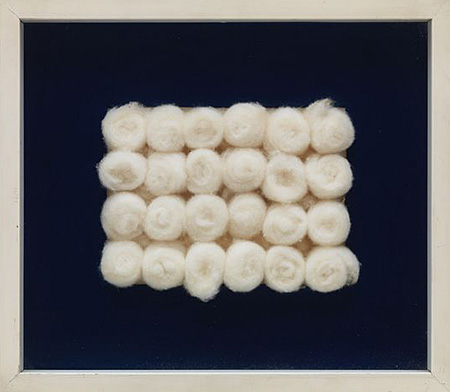
Continuing through April 7, 2019
Although Piero Manzoni died prematurely at the age of 30, the legacy of this pioneer of Italian conceptual art is well documented and firmly cemented in this exhibition of “Achromes,” a series created during the last four years of his life. A forerunner of the late 1960s Italian “Arte Povera” movement, Manzoni believed that painting had run its course as a viable medium, and thus he experimented with a range of materials as replacements for oil paint. Included in the exhibition are mostly wall works constructed from such materials as raw canvas, white clay (kaolin), natural, glass, and synthetic fibers, silk, cotton wool, rabbit skin, cloth, polystyrene, phosphorescent paint, cobalt chloride, packaging paper, straw, stones, pebbles, and even bread. The exhibition also includes two installations that Manzoni envisioned in a letter, but never lived to see realized: a room covered in white fur, and another painted in phosphorescent paint. All but a few of the works on view are white, which Manzoni viewed as being without color. Where there were exceptions, he considered color to be inherent to a material and not an aesthetic property.
The principal idea underlying Manzoni’s “Achromes” series was to replace attitudes towards painting and related attributes (pictorial relationships, representation, and expression) with what would soon become a widely accepted viewpoint among Minimalists: that an art object should refer to nothing other than the object itself. While Manzoni seems to have achieved this goal in the bulkier relief objects made of fibers, most of the works on view succeed by conventional aesthetic standards because they do not perform as the artist intended, both in formal and metaphoric terms. Grids made of rolled-up cotton balls are sumptuously tactile, while also suggestive of boxed candy or sushi platters. A freestanding sculpture made from strands of straw evokes associations with farm labor. Allover compositions of polystyrene balls dazzle with energy. Boxed packages tied in string and stamped in sealing wax appear poetic and mysterious. And grids of bread feel like they are staring at us like sinister monsters. Although Manzoni viewed his art as unconventional and specific to the era when it was created, his oeuvre is far greater than that because it remains relevant and engaging to those of us who value the pure pleasures of viewing.
